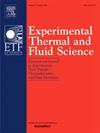在电弧喷射环境中热保护系统碎裂时形成的微粒的测量
IF 3.3
2区 工程技术
Q2 ENGINEERING, MECHANICAL
Experimental Thermal and Fluid Science
Pub Date : 2025-04-08
DOI:10.1016/j.expthermflusci.2025.111487
引用次数: 0
摘要
在美国宇航局艾姆斯的空气动力加热设施中进行了一项电弧喷射运动,通过估计从这些材料中喷射出的颗粒的大小以及相应的质量损失来研究热保护系统材料的剥落。颗粒大小是通过颗粒跟踪测速法分析确定的,利用颗粒上的力平衡,以及通过有针对性地设计测试物品直接测量捕获的颗粒。对捕获粒子的分析显示,它们呈现出不同的几何形状,包括细颗粒、单个纤维和多纤维团块。每种粒度法需要不同的方法来确定颗粒数量,以及相应的质量损失。然而,两种技术测定的质量损失值相似。此外,还发现颗粒尺寸分布与表面热流密度无关,也与碳预制体是否添加酚醛树脂无关。然而,研究发现,酚醛树脂的存在导致颗粒生成速率明显降低,这可能是由于酚醛树脂的热解减少了自由流中氧气向样品中的扩散。本文章由计算机程序翻译,如有差异,请以英文原文为准。
Measurement of particulates formed during thermal protection system spallation in an arc-jet environment
An arc-jet campaign conducted in the Aerodynamic Heating Facility at NASA Ames was conducted to investigate the spallation of thermal protection system materials by estimating the size of particles ejected from these materials, as well as the corresponding mass loss. Particle sizes were determined both from analysis of particle tracking velocimetry, utilizing a force balance on the particulates, and by direct measurement of particles captured through targeted design of the test articles. Analysis of the captured particles revealed that they took on different geometries consisting of fine particulates, individual fibers, and clumps of multiple fibers. Different methods were required for each particle sizing approach to determine particle quantities, and corresponding mass loss. However, similar values for mass loss were determined using both techniques. In addition, it was found that the particle size distributions were independent of surface heat flux, and whether the carbon preform contained additional phenolic resin. It was found, however, that the presence of phenolic resin caused a measurable reduction in the rate of particle production, potentially due to its pyrolysis reducing the diffusion of oxygen from the free stream into the sample.
求助全文
通过发布文献求助,成功后即可免费获取论文全文。
去求助
来源期刊

Experimental Thermal and Fluid Science
工程技术-工程:机械
CiteScore
6.70
自引率
3.10%
发文量
159
审稿时长
34 days
期刊介绍:
Experimental Thermal and Fluid Science provides a forum for research emphasizing experimental work that enhances fundamental understanding of heat transfer, thermodynamics, and fluid mechanics. In addition to the principal areas of research, the journal covers research results in related fields, including combined heat and mass transfer, flows with phase transition, micro- and nano-scale systems, multiphase flow, combustion, radiative transfer, porous media, cryogenics, turbulence, and novel experimental techniques.
 求助内容:
求助内容: 应助结果提醒方式:
应助结果提醒方式:


